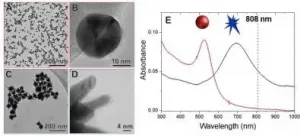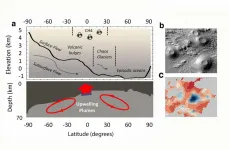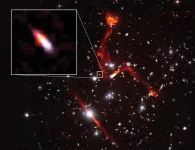What sparked life on Earth? Perhaps bolts from the blue
2021-03-16
(Press-News.org) Lightning strikes -- perhaps a quintillion of them, occurring over a billion years -- may have provided sparks of life for the early Earth.
A new study by researchers at Yale and the University of Leeds contends that over time, these bolts from the blue unlocked the phosphorus necessary for the creation of biomolecules that would be the basis of life on the planet.
"This work helps us understand how life may have formed on Earth and how it could still be forming on other, Earth-like planets," said lead author Benjamin Hess, a graduate student in Yale's Department of Earth & Planetary Sciences.
In part, it starts with phosphorus, Hess said.
Phosphorus is a key ingredient necessary for the formation of life -- but it was not easily accessible on Earth billions of years ago. For the most part, phosphorus was locked tightly inside insoluble minerals on Earth's surface.
The question for researchers has been: How did Earth's phosphorus get into a usable form to help create DNA, RNA, and other biomolecules needed for life?
Scientists looked first at meteorites. The idea was that meteorites containing the phosphorus mineral schreibersite -- which is soluble in water -- crashed on Earth's surface with enough frequency to create the conditions necessary for biological life.
The drawback to the meteorite theory, however, had to do with frequency. During the period when life is thought to have begun, anywhere from 3.5 to 4.5 billion years ago, the frequency of meteorite collisions on Earth plummeted.
But there was another source of the phosphorus found in schreibersite. According to Hess, schreibersite can also be found in certain glasses -- called fulgurites -- that form when lightning strikes the ground. The glass contains some of the phosphorus from surface rock, but in soluble form.
Using results from computer modeling, Hess and co-authors Sandra Piazolo and Jason Harvey from the University of Leeds estimated that early Earth saw 1 to 5 billion lightning flashes every year (compared to about 560 million flashes per year today). Of those early flashes, anywhere from 100 million to 1 billion would have struck the ground annually.
That would add up to 0.1 to 1 quintillion strikes -- and quite a bit of usable phosphorus -- after a billion years.
The lightning strike theory has other advantages as well, the researchers noted. First, the annual number of lightning strikes would have remained constant, unlike the number of meteorite collisions. In addition, lightning strikes were likely to be most prevalent on land masses in tropical regions, providing more concentrated areas of usable phosphorus.
"It makes lightning strikes a significant pathway toward the origin of life," Hess said.
INFORMATION:
The new study appears in the journal Nature Communications. Financial support from Yale helped fund the research.
ELSE PRESS RELEASES FROM THIS DATE:
2021-03-16
Lightning strikes were just as important as meteorites in creating the perfect conditions for life to emerge on Earth, geologists say.
Minerals delivered to Earth in meteorites more than 4 billion years ago have long been advocated as key ingredients for the development of life on our planet.
Scientists believed minimal amounts of these minerals were also brought to early Earth through billions of lightning strikes.
But now researchers from the University of Leeds have established that lightning strikes were just as significant as meteorites in performing this essential function and allowing life to manifest.
They say this shows that life could develop on Earth-like planets through the same mechanism at any time if atmospheric conditions are right. The research ...
2021-03-16
The activity of enzymes in industrial processes, laboratories, and living beings can be remotely controlled using light. This requires their immobilization on the surface of nanoparticles and irradiation with a laser. Near-infrared light can penetrate living tissue without damaging it. The nanoparticles absorb the energy of the radiation and release it back in the form of heat or electronic effects, triggering or intensifying the enzymes' catalytic activity. This configures a new field of study known as plasmonic biocatalysis.
Research conducted at the University of São Paulo's Chemistry Institute (IQ-USP) in Brazil investigated the activity of enzymes immobilized on gold ...
2021-03-16
FLAGSTAFF, Ariz. -- March 16, 2021 -- The findings of a recent analysis conducted by the Translational Genomics Research Institute (TGen), an affiliate of City of Hope, suggest that ecosystems suitable for harboring ticks that carry debilitating Lyme disease could be more widespread than previously thought in California, Oregon and Washington.
Bolstering the research were the efforts of an army of "citizen scientists" who collected and submitted 18,881 ticks over nearly three years through the Free Tick Testing Program created by the Bay Area Lyme Foundation, which funded the research, producing a wealth of data for scientists to analyze.
This new study builds on initial research led by the ...
2021-03-16
March 16, 2021, Mountain View, CA - In a comment published today in Nature Astronomy, Dr. Nathalie Cabrol, Director of the Carl Sagan Center for Research at the SETI Institute, challenges assumptions about the possibility of modern life on Mars held by many in the scientific community.
As the Perseverance rover embarks on a journey to seek signs of ancient life in the 3.7 billion years old Jezero crater, Cabrol theorizes that not only life could still be present on Mars today, but it could also be much more widespread and accessible than previously believed. Her conclusions are based on years of exploration of early Mars analogs in extreme environments in the Chilean altiplano and the Andes funded ...
2021-03-16
Billions of years ago, the Red Planet was far more blue; according to evidence still found on the surface, abundant water flowed across Mars and forming pools, lakes, and deep oceans. The question, then, is where did all that water go?
The answer: nowhere. According to new research from Caltech and JPL, a significant portion of Mars's water--between 30 and 99 percent--is trapped within minerals in the planet's crust. The research challenges the current theory that the Red Planet's water escaped into space.
The Caltech/JPL team found that around four billion years ago, Mars was home to enough water to have covered the whole planet in an ocean about 100 to 1,500 meters deep; a volume roughly ...
2021-03-16
URBANA, Ill. - Corn didn't start out as the powerhouse crop it is today. No, for most of the thousands of years it was undergoing domestication and improvement, corn grew humbly within the limits of what the environment and smallholder farmers could provide.
For its fertilizer needs, early corn made friends with nitrogen-fixing soil microbes by leaking an enticing sugary cocktail from its roots. The genetic recipe for this cocktail was handed down from parent to offspring to ensure just the right microbes came out to play.
But then the Green Revolution changed everything. Breeding tools improved dramatically, leading to faster-growing, higher-yielding hybrids than the world had ...
2021-03-16
Radio telescopes are the world's most sensitive radio receivers, capable of finding extremely faint wisps of radio emission coming from objects at the farthest reaches of the universe. Recently, a team of astronomers used the National Science Foundation's Karl G. Jansky Very Large Array (VLA) to take advantage of a helping hand from nature to detect a distant galaxy that likely is the faintest radio-emitting object yet found.
The discovery was part of the VLA Frontier Fields Legacy Survey, led by NRAO Astronomer Eric Murphy, which used distant clusters of galaxies as natural lenses ...
2021-03-16
Recent research shows that people are more likely to take "microbreaks" at work on days when they're tired - but that's not a bad thing. The researchers found microbreaks seem to help tired employees bounce back from their morning fatigue and engage with their work better over the course of the day.
At issue are microbreaks, which are short, voluntary and impromptu respites in the workday. Microbreaks include discretionary activities such as having a snack, chatting with a colleague, stretching or working on a crossword puzzle.
"A microbreak is, by definition, short," says Sophia Cho, co-author of a paper on the work and an assistant professor ...
2021-03-16
RESEARCH TRIANGLE PARK, N.C. -- Joint Army- and Air Force-funded researchers have taken a step toward building a fault-tolerant quantum computer, which could provide enhanced data processing capabilities.
Quantum computing has the potential to deliver new computing capabilities for how the Army plans to fight and win in what it calls multi-domain operations. It may also advance materials discovery, artificial intelligence, biochemical engineering and many other disciplines needed for the future military; however, because qubits, the fundamental building blocks of quantum computers, are intrinsically fragile, a longstanding barrier to quantum computing has been effective implementation of quantum error correction.
Researchers at University of Massachusetts Amherst, ...
2021-03-16
Corporate strategies should be as unique as possible, in fact highly specific to each individual company. This enables companies to compete successfully in the long term. However, the capital market and others, including analysts, often react negatively to the idea of unique strategies. The reason is that deviating from typical industry standards makes them more complex to evaluate. This regularly discourages companies from focusing on unique strategies, even though they would be beneficial for the company in the long term. This contradiction is known as the "uniqueness paradox". A research team from the Universities of Göttingen and Groningen has investigated the influence of different types of investors on the extent of the paradox and thus on the choice of unique strategies. The results ...
LAST 30 PRESS RELEASES:
[Press-News.org] What sparked life on Earth? Perhaps bolts from the blue




